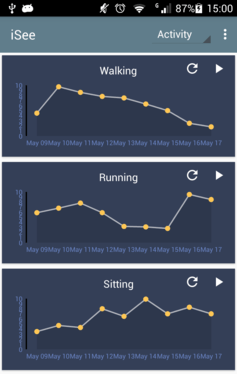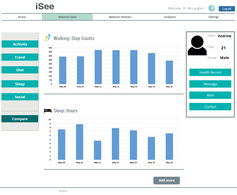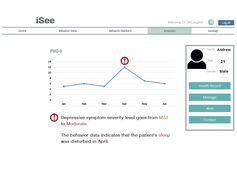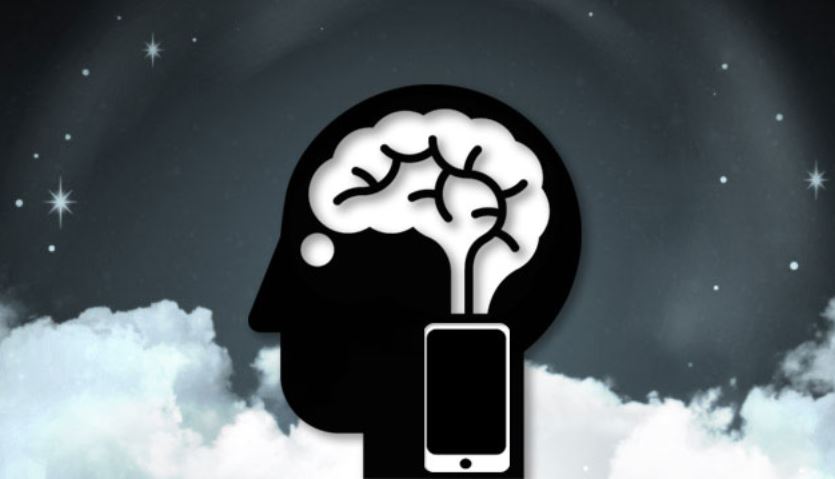Predictive technology is exploding across the virtual landscape. The arrival of Big Data initiatives by government, as well as a massive industry of data brokers is not only putting privacy at risk, but is offering those with access to the information unprecedented ways to micromanage our lives.
Most people now seem resigned to the surveillance of our communications devices, which have become so intertwined with modern efficiency, economics and knowledge that there are real tradeoffs when choosing a fully opt-out lifestyle. Wearable gadgets add a new layer still, and are being bought into at record pace, thus donating the information that isn’t already being stolen.
However, it might be our health information that is the most tempting, offering up potentially the most intrusive window yet into our everyday lives.
A group of university researchers studying the rising levels of depression in university students have just released their latest concept for a mental health tracking app called iSee that, in their words, will “enhance counseling services with mobile technology and big data analytics.” The system works with students who voluntarily want to have their daily movements tracked in order to provide data that might offer clues to a computer algorithm that can detect if they are experiencing signs of depression. The entire article is posted below with my highlights, but I’d first like to offer some additional background to this type of technology and why it very well could move from voluntary to mandatory over time.
In July of 2104 I covered a development by researchers at Tel Aviv University who stated that a “Smartphone App May Revolutionize Mental Health Treatment.” The following excerpts from the press release were highlighted as some very stark writing on the wall.
- There is a dire need for support services to assist clinicians in the evaluation and treatment of those suffering from mental illness.
- A new smartphone-based system detects changes in patients’ behavioral patterns, and then transmits them to professionals in real time.
- By facilitating patient observation through smartphones, the technology also affords patients much-needed independence from hospitals, clinicians — and even family members.
- Because most people own smartphones today, we thought, Why not harness the smartphone, a reservoir of daily activities, to monitor behavioral patterns? “Bipolar disorder, for example, starts with a manic episode,” said Dr. Nevo. “A patient who usually makes five or ten calls a day might suddenly start making dozens of calls a day. How much they talk, text, how many places they visit, when they go to bed and for how long — these are all indicators of mental health and provide important insights to clinicians who want to catch a disorder before it is full blown.”
Full press release available HERE
Almost exactly one year later, a group of researchers proclaimed that the standard smartphone can accurately detect general depression with nearly 90% accuracy, merely based on GPS location data and usage information. Researchers seemed preliminarily overjoyed, in my view, from the results obtained from just 40 participants, but it is worth noting what their objective and conclusions state:
Objective: The objective of this study was to explore the detection of daily-life behavioral markers using mobile phone global positioning systems (GPS) and usage sensors, and their use in identifying depressive symptom severity.
Conclusions: Features extracted from mobile phone sensor data, including GPS and phone usage, provided behavioral markers that were strongly related to depressive symptom severity. While these findings must be replicated in a larger study among participants with confirmed clinical symptoms, they suggest that phone sensors offer numerous clinical opportunities, including continuous monitoring of at-risk populations with little patient burden and interventions that can provide just-in-time outreach. (emphasis added)
Source and full release HERE
Beyond the mountain of technical details, the upshot is that the complex movements, thoughts and desires of an individual human being are being replaced by an algorithmic overlay of sensor feed results that can be transmitted to centralized professionals who apparently know you better than yourself or your family and friends.
Did you know, for example, that the average smartphone user time for a depressed person is 68 minutes? Did you know that 17 minutes makes you normal?
Using terms like “location variance” “clustering” “circadian movement” and “transition time” is the standard operating procedure for reductionists and technocrats everywhere whose #1 trait is what Jon Rappoport has called OTO – The Obsession to Organize:
OTO speaks of a bottomless fear that somewhere, someone might be living free.
The presumption of a baseline, incontestable “normal” level of mental health speaks to the need for power structures and the medical establishment to seek as many diagnoses as possible to corral and monetize populations deemed to be wandering too far off the plantation.
 And this is where things can go from having a genuine concern for the well-being of others … to labels and categorizations that reduce natural rights and the very essence of what it means to be a human being.
And this is where things can go from having a genuine concern for the well-being of others … to labels and categorizations that reduce natural rights and the very essence of what it means to be a human being.
Do you like to disconnect from the virtual matrix for a while? Take a stay-cation? Do you generally enjoy your home and family more than social carousing, mall strolling, and indiscriminate consumerism?
You’ve been deemed NOT AVERAGE – Red Flag in Sector 12.
And the political framework already has been created for the government to impose itself into the health lives of every individual.
As Jon Rappoport has highlighted, embedded in the Patient Protection and Affordable Care Act (aka Obamacare), it states quite clearly the value of data obtained from gadgets and consumer behavior, and portends how government might mandate changes in the near future.
Health plans, integrated delivery systems, and other health care organizations (HCOs) increasingly channel their patients to interventions based in part on what they deduce from predictive models that have traditionally been run against databases of administrative claims. In this arena, the Affordable Care Act (ACA) [Obamacare] is likely to exert a profound effect.
…a growing number of health care experts…see predictive modeling as an opportunity to prevent [disease] complications, control [hospital] readmissions, generate more precise diagnoses and treatments, predict risk, and control costs for a more diverse array of population segments than previously attempted…
New data streams will become available to providers, payers, and government as EHRs draw from a broader array of data to create more complete insight into patients and the care delivery process…As HCOs gain access to data from more varied sources, such as health risk assessments, behavioral assessments, laboratory results, and pharmacy prescriptions (filled and unfilled), the impact of predictive modeling will increase. (emphasis added)
Source: “More Data in Health Care Will Enable Predictive Modeling Advances.” Managed Care
Finally, if any doubts remain about how slippery this slope has become, listen to the following statement from David Mohr – director of the Orwellian Center for Behavioral Intervention Technologies at Northwestern University Feinberg School of Medicine (and, by the way, part of the latest research posted in the article that follows):
The significance of this is we can detect if a person has depressive symptoms and the severity of those symptoms without asking them any questions … We now have an objective measure of behavior related to depression. And we’re detecting it passively. Phones can provide data unobtrusively and with no effort on the part of the user.
What a dream – effortless transmission of what makes you tick … all you have to do is wait for the Intervention Team to arrive.
And now, as you’ll read below, they are aiming for the youth – the struggling university student.
 Of course the central question is not addressed here: Why are so many students depressed? Could it be the massive debt they need to incur in order to participate in this “normal” society? Could it be the mere activity of running the gauntlet that is the modern college experience which, in my view, creates neuroses with its increasingly dominant focus on political correctness, safe spaces, and whatever other social engineering programs are being touted outside the boundaries of truly rigorous study and devotion to knowledge? I’m sure it couldn’t possibly be that the combination of debt, social stress, engineered stripping of identity and individualism – and now being virtually stalked and judged in real-time about their “abnormal” mental state – finishes only with the likelihood that, after such a trial, the degree that has been slavishly pursued could be utterly worthless.
Of course the central question is not addressed here: Why are so many students depressed? Could it be the massive debt they need to incur in order to participate in this “normal” society? Could it be the mere activity of running the gauntlet that is the modern college experience which, in my view, creates neuroses with its increasingly dominant focus on political correctness, safe spaces, and whatever other social engineering programs are being touted outside the boundaries of truly rigorous study and devotion to knowledge? I’m sure it couldn’t possibly be that the combination of debt, social stress, engineered stripping of identity and individualism – and now being virtually stalked and judged in real-time about their “abnormal” mental state – finishes only with the likelihood that, after such a trial, the degree that has been slavishly pursued could be utterly worthless.
Helping universities combat depression with mobile technology
By Mi Zhang, Michigan State University; David Mohr, Northwestern University, and Jingbo Meng, Michigan State University
Depression is the leading mental health issue on college campuses in the U.S. In 2015, a survey of more than 90,000 students at 108 American colleges and universities found that during the previous year, more than one-third of them had felt so depressed at some point that it was difficult to function. More than two-thirds had felt hopeless in the preceding academic year.
Today’s college students are dealing with depression at an alarmingly high rate, and are increasingly seeking help from on-campus mental health services. Depression is also an underlying cause of other common problems on college campuses, including alcohol and substance abuse, eating disorders, self-injury, suicide and dropping out of school.
But university counseling centers, the primary sources for students to get mental health care, are struggling to meet this rising demand. First, it can take a long time for clinicians to gain a full picture of what students are experiencing: Depressed students’ accounts of their symptoms are often inaccurate and incomplete.
In addition, budget constraints and limited office hours mean the number of clinicians on campus has not grown, and in some cases has shrunk, despite increasing demand. There simply are not enough university clinicians available to serve every student – and few, if any, at critical times like nights and weekends. The number of students on counseling waiting lists doubled from 2010 to 2012. This can leave students waiting long periods without help. In the worst cases, this can have lifelong – or life-ending – consequences.
Using mobile technology for mental illness diagnosis and treatment is becoming a hot research topic nowadays because of the pervasiveness of mobile devices and their behavior-tracking capabilities. Building on others’ work, we have found a way to enhance counseling services with mobile technology and big data analytics. It can help students and clinicians alike, by offering a new tool for assessing depression that may shed increased light on a condition that is challenging to study.
Measuring well-being
 The iSee app’s main screen shows activity trends. Mi Zhang and Jingbo Meng, CC BY-ND
The iSee app’s main screen shows activity trends. Mi Zhang and Jingbo Meng, CC BY-ND
We are developing a system for tackling this campus mental health crisis, called iSee. When it’s ready to be deployed, students who participate in the program will need to carry a smartphone and a smartwatch. Data collected by those devices are transmitted to, and analyzed by, a computer system. This lets the relatively few counselors keep better track of more students – extending service to more students in need.
The smartphone and smartwatch have several built-in sensors:
- a GPS sensor, to track geographical locations,
- a light sensor, to measure ambient light levels,
- an accelerometer, to capture physical movements, and
- a touchscreen, to monitor the frequency and duration of users’ interactions with their phones, such as browsing social media.
These sensors capture many of the students’ daily activities that can help indicate mental well-being, including walking or other physical exercise, sleeping habits, social interaction and how often they go to class or local businesses – or whether they stay home or in a dorm room all day long.
RFID Scan Blockers – Available for Free (Ad)
iSee can offset the inherent inaccuracies and incompleteness in patients’ self-reporting of their depression. It can even observe symptoms students themselves don’t notice or think to mention to a counselor. And because the data are continually collected, it can identify moments of vulnerability and resilience and provide a picture of a student’s progress over time. That can help not only monitor but also treat depression.
Improving counseling service
 Counselors can keep an eye on their patients, without even needing to make direct contact. Mi Zhang and Jingbo Meng, CC BY-ND
Counselors can keep an eye on their patients, without even needing to make direct contact. Mi Zhang and Jingbo Meng, CC BY-ND
Our work builds on the algorithms we have designed that analyze mobile device data to detect depression. In a 2015 study, we showed that the severity of a person’s depression can be predicted by monitoring their GPS locations and how often they use their phones: People with more severe depression symptoms tended to move from place to place less and stay at home more than people with fewer depression symptoms – or none at all. The movements of more severely depressed people also tended to be less regular, and were more likely to use their phones frequently and for longer durations. For iSee, we will incorporate data from the other sensors, translating the raw measurements into models of how the students are behaving.
Then iSee will look for behavior patterns that can relate to mental health problems – such as staying home all the time or getting irregular sleep. By sharing this information with both the patient and the counselor, iSee will help better describe, and more accurately portray the severity of, an individual’s symptoms.
Treating depression
 A mental health counselor can see when a student’s behavior suggests a change in their depression. Mi Zhang and Jingbo Meng, CC BY-ND
A mental health counselor can see when a student’s behavior suggests a change in their depression. Mi Zhang and Jingbo Meng, CC BY-ND
In addition, iSee can sense in real time when a student’s behavior matches certain symptoms of depression – such as being socially isolated for three days. If that happens, the app can automatically deliver in-the-moment therapies to help, without relying on the patient, or even the clinician, to initiate. For example, if iSee notices a socially isolated person is alone at home on a sunny Saturday afternoon, it might suggest calling some friends or going out for a walk.
 That is exactly the sort of suggestion a counselor would make. Unfortunately, counselors usually can only make these suggestions in hindsight during therapy sessions. The smartphone can provide that assistance in the moment when help is needed.
That is exactly the sort of suggestion a counselor would make. Unfortunately, counselors usually can only make these suggestions in hindsight during therapy sessions. The smartphone can provide that assistance in the moment when help is needed.
By finding ways the many sensors on smartphones and smartwatches can shed light on people’s daily lives and habits, and by analyzing that data in ways that highlight potential mental health problems, we can help college students stay healthier and reduce the workload on overtaxed professionals at the same time.
Mi Zhang, Assistant Professor of Electrical and Computer Engineering, Michigan State University; David Mohr, Director, Center for Behavioral Intervention Technologies (CBITs) Professor of Preventive Medicine (Behavioral Medicine), Medical Social Sciences and Psychiatry and Behavioral Sciences, Northwestern University, and Jingbo Meng, Assistant Professor of Communication, Michigan State University
This article was originally published on The Conversation. Read the original article.
Nicholas West writes for ActivistPost.com. This article can be freely republished in part or in full with author attribution and source link.


Scary for sure. There is no doubt about it.
On the other had this will lead to everyone taking gender studies to be put in a padded room or “safe space” as there called on campus.
It’s going to monitor their minds? Where is that?
Let’s see….replace observant and caring adults, such as parents, counselors and teachers, with more AI machines? If this is really necessary, then we might as well toss in the towel. First we have medical doctors and schools giving heavy duty anti-depressant and psychotropic drugs to tens of millions of children from ages 3 to 18, now we have that being monitored by robots? No wonder parents have abdicated their roles. With all the drugs and robots doing the job, parents can spend more time on their cell phones and Apps. Mindless zombies with mindless zombie children.
If all the technology stops working then we will see the zombies. Lost in the space left by these Apps and other control devices. What is the purpose of being here? To have a love affair with a cell phone? or to grow in other ways?
Big pharma is really starting to get desperate for business here.